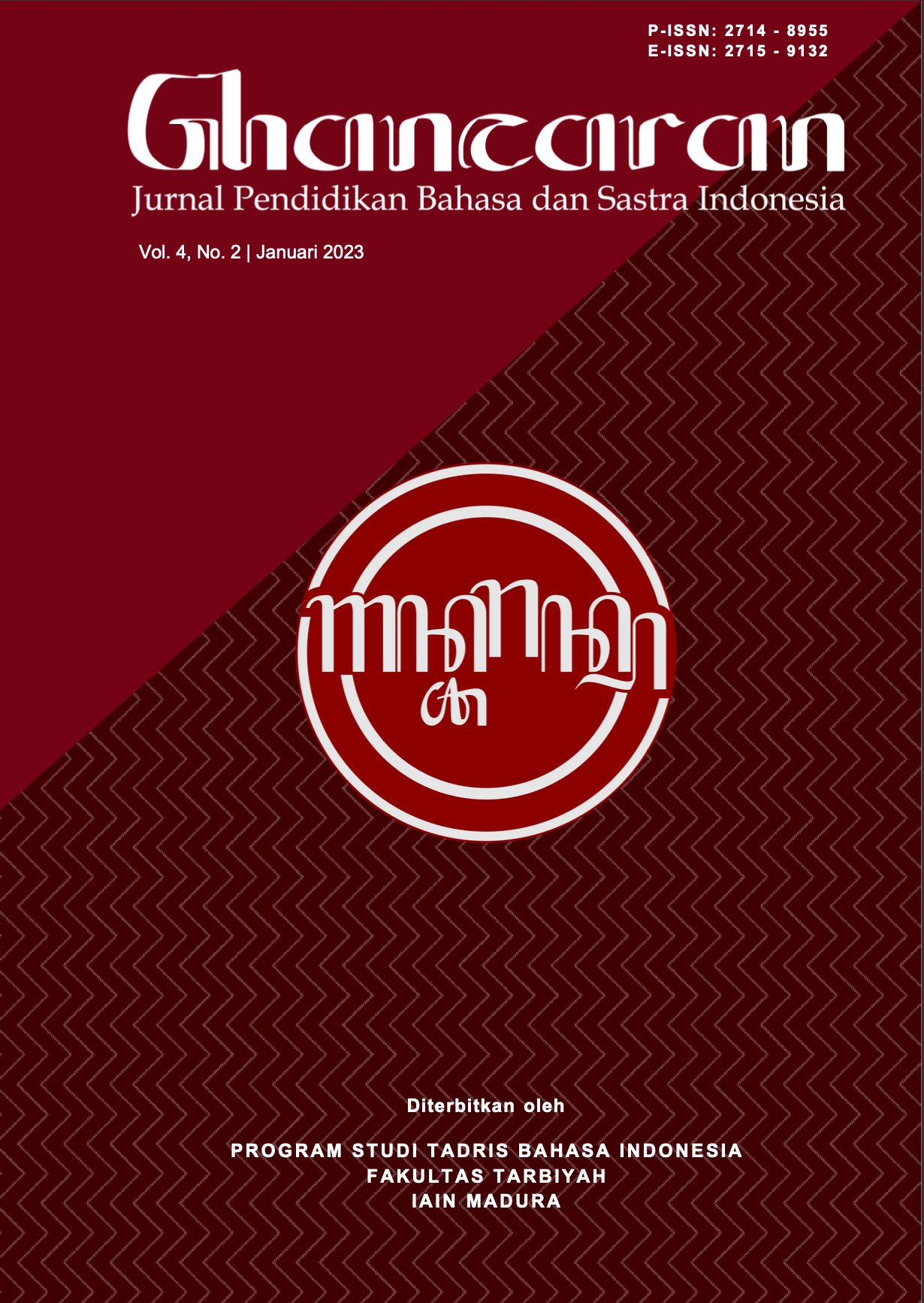Kajian Literatur Penilaian Guru terhadap Keterampilan Siswa dalam Membaca Puisi Tahun 2015—2021
 Abstract views: 934
,
Abstract views: 934
,
 PDF downloads: 1795
PDF downloads: 1795
Abstract
The teacher's assessment of students' poetry reading skills has differences in research instruments, especially in the assessment aspect. The assessment instrument used in poetry reading skills is adjusted to the elements contained in the poem. This study aims to describe the literature review of the instruments used in poetry reading assessment. This study used a qualitative method with a literature review approach. The research stages were carried out starting from article collection, article reduction, article display, discussion, and conclusion. Sources of research data are in the form of national articles in the last 6 years (2015-2021). The results showed that the aspect that was often assessed was the aspect of intonation with a percentage of 21%, while the aspect that was rarely used was the aspect of articulation, interpretation and stage mastery with a percentage of 1%. There was also an addition to the assessment aspect of poetry reading from year (2015-2021).
Downloads
References
September.
Arofah, F., & Anis, M. B. 2020. Pengembangan Keterampilan Membaca Puisi Dengan Teknik
Permodelan Par (Participatory Action Research) Pada Siswa. GHANCARAN: Jurnal
Pendidikan Bahasa Dan Sastra Indonesia, 2(1).
https://doi.org/10.19105/ghancaran.v2i1.2991
Dinas Pendidikan dan Kebudayaan Kabupaten Madiun,
https://dindik.madiunkab.go.id/index.php/en/2017-03-21-15-01-27/bidang-pembinaansmp/791-lomba-cipta-dan-baca puisi# ) diunduh pada Senin, 18-April-2022.
Harras, K. A., & Sulistianingsih., L. 1998. Membaca 1. Departemen Pendidikan dan Kebudayaan.
Harthaty, Indrie. Nasir, Muhamad. Tentang Sastra Orkestrasi Teori dan Pembelajarannya.
Yogyakarta: Garudhawaca.
Ismulya, E. S., Amalia, A. R., & Maula, L. H. 2020. “Peningkatan Keterampilan Membaca Puisi
Siswa Melalui Model Pembelajaran Quantum Teaching Pada Siswa di Kelas Tinggi
Sekolah Dasar”. Jurnal Perseda, 3(1).
Kadir, Hersin. Puluhulawa, Lian. 2013. Pias-Pias Materi Bahasa Indonesia Untuk Kelas XII
SMA/MA/. Yogyakarta: Deepublish.
Magdalena, Ina. 2020. Evaluasi Pembelajaran SD (Teori dan Praktik). (Jawa Barat: CV Jejak).
Maryani, I., & Fatmawati, L. 2015. IbM Active Learning Guru SD dan Pelatihan Penilaian. Modul
Pelatihan, 1–110. http://eprints.uad.ac.id/6580/1/MODUL IbM - PENILAIAN
AUTENTIK.pdf.
Pitriani, A., Heryadi, D., & Nurani, R. Z. 2019. “Meningkatkan Kemampuan Membaca Puisi
Melalui Penerapan Model Dramatic Learning Kelas IV SDN 4 Tugu Tasikmalaya. 4th
National Seminar on Guidance and Counseling (SNBK 2019) and Workshop on
Pedagogical Theory and Practice (WTPP 2019)”.
Pradopo, R. D. 1978. Pengertian, Hakikat, dan Fungsi Puisi. Modul 1.
Samsiyah, Nur. 2016. Pembelajaran Bahasa Indonesia di SD Kelas Tinggi. Jawa Timur:CV AE
Media Grafika.
Sayuti, S. A. 2010. Berkenalan dengan Puisi. Jakarta: Gramedia.
Subahan, Alpi. 2021. “Kajian Literatur Tentang Kebijakan Pendidikan Dasar di Masa Pandemi
dan Dampaknya Terhadap Pembelajaran”. Artikel Review Pendidikan dan Pengajaran.
Volume 4 Nomor 1.
Wahyuningsih, U., Razak, A., & Burhanudin, D. (n.d.). The Ability Of The First Year Students Of
Mts Al-Uswah Pekanbaru In Reading Poetry Siswa Kelas Vii Mts Al-Uswah Pekanbaru.
59(2).
Wicaksono, A. 2019. Apresiasi Puisi Indonesia. Jawa Barat. CV. Anugrah Utama Raharja.
Widharyanto, B. Prijowuntato, S Widanarto, Menilai Peserta Didik. Yogyakarta: Sanata Dharma
University Press.
Copyright (c) 2023 GHANCARAN: Jurnal Pendidikan Bahasa dan Sastra Indonesia

This work is licensed under a Creative Commons Attribution-ShareAlike 4.0 International License.
Ghancaran: Jurnal Pendidikan Bahasa dan Sastra Indonesia uses an Open Access Policy under the Creative Commons Attribution-ShareAlike 4.0 International License. Authors publishing in this journal agree to the following terms:
- Ghancaran Journal holds the copyright and grants the journal rights for first publication with the work simultaneously licensed under a

The work is distributed under Creative Commons Attribution-ShareAlike 4.0 International License which allows others to share, copy, and redistribute the material in any media or format and adapt, remix, change, and develop the material even for commercial purposes, as long as it is stated credit and license derivative works under similar terms. - Authors may make additional contractual arrangements for non-exclusive distribution of the journal's published work version.
- Authors are permitted to post their work online (e.g., in institutional repositories or on their websites) before and during submission, as doing so may lead to productive exchange.



















